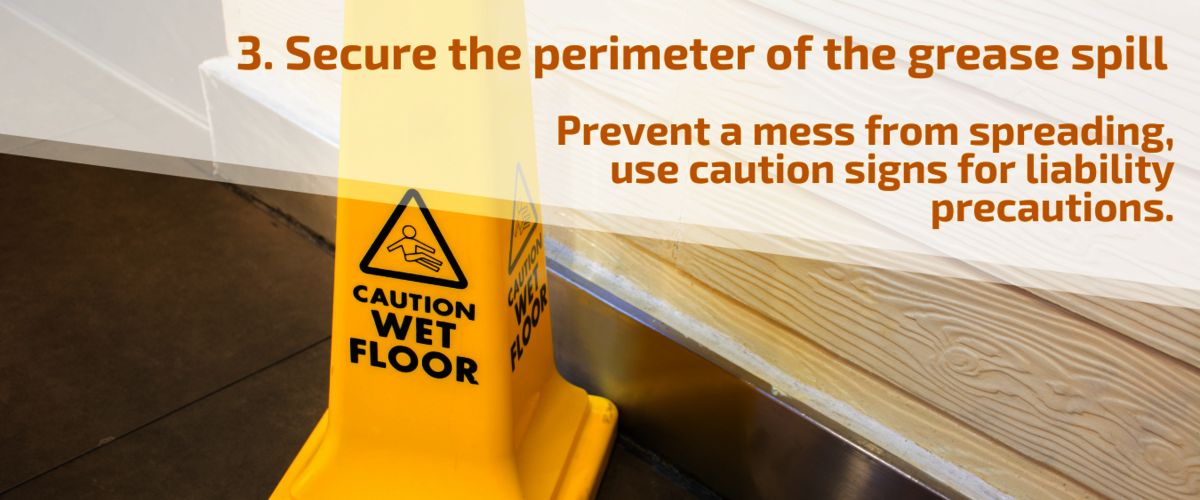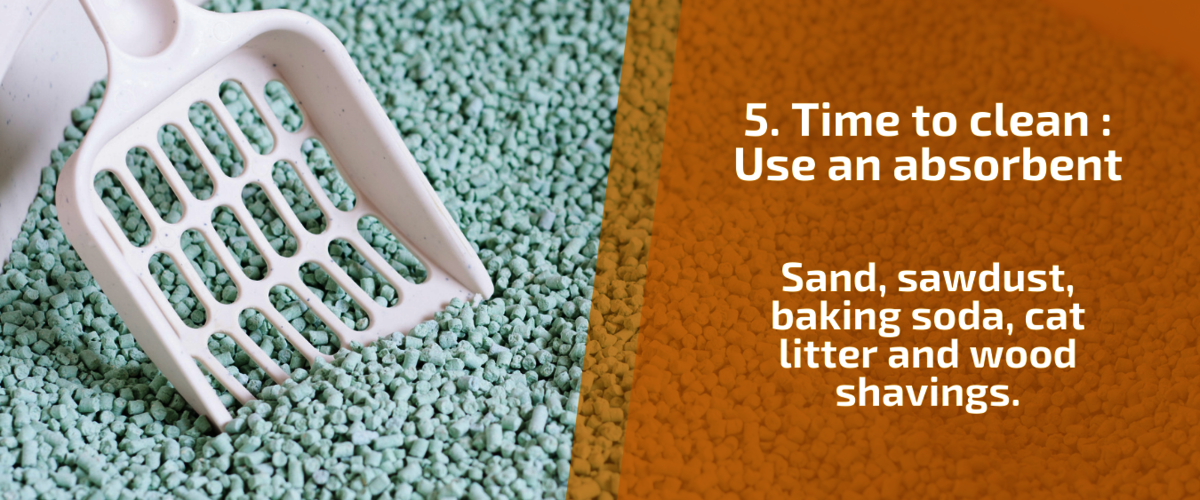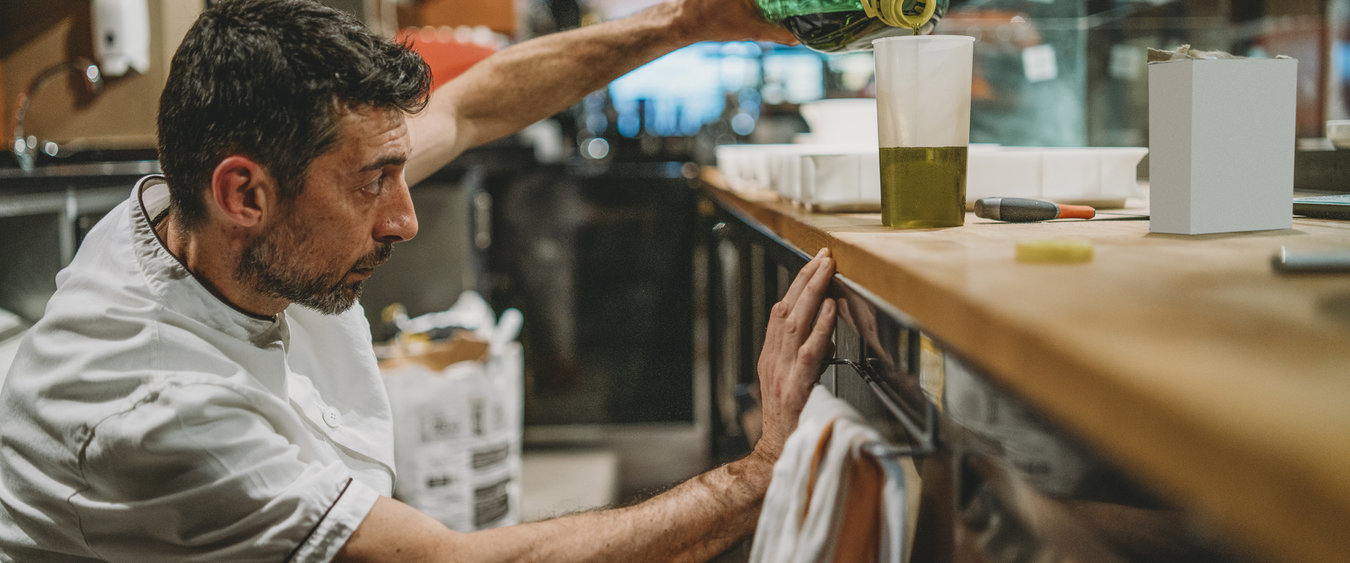1. Identify the source of the cooking oil leak or spill
Not all grease spills are the same in terms of where they originate. They can come from a variety of different sources. It could be as simple as your employee spilling a bucket on the way out to manually pour it into an outdoor bin (which is why automated equipment is always recommended). It could also mean your tank or bin is overflowing -- or that there is a leak in the tank. Being proactive in looking for leaks is important in catching grease spills before they spread.
Lastly, it could also be an issue with your grease trap system. Not to be confused with the storage tank that holds your spent oil, your grease trap holds all the waste that goes down your drain. A clog in your inlet or outlet pipe could lead to a major issue either in your kitchen or out of the trap located in your parking lot.
Identifying the source of a grease spill or leak is the first step toward solving the problem.
2. Call your grease recycling provider or a plumber
After you’ve identified the source, the next thing you should do is call your grease recycling partner or your plumber. Which of the two you call depends on the source of the mess. If the spill originated from a leak in your tank or an overflow, you should call your provider to either come pick up your full tank or inspect the leak. If it’s simply just an employee spill, you likely don’t need to call your provider and can properly clean the spill by following the steps below.
If the spill is coming from your grease trap, you should call a plumber. Your grease recycling provider is unlikely to be able to help you in the event of an inlet or outlet pipe clog and very rarely does a leak or clog stem from the trap itself. A plumber will be much more useful in helping solve the problem.
It will take time for either one to arrive at your business and there are things you can do in the meantime to mitigate the problem or, depending on how large the spill is, clean up entirely.

3. Secure the perimeter of the grease spill
Grease spreads rapidly when it is spilled. This is the predominant reason why grease spills and leaks can be such a hazardous mess to corral. Securing the perimeter around the initial spill area is a crucial measure to stopping the spread of the spill. Use some sort of solid, flexible material like a garden hose to wrap around the spill to prevent the mess from spreading further.
Next, you need to alert both customers and staff of the issue should they encounter the area of the spill. Caution signs are a must from a liability standpoint. This is important regardless of whether it’s inside your kitchen or outside of your restaurant, but particularly outside the restaurant where your guests are more likely to see the messy area.
4. Remove any debris from the area
Once you have the spread under control, you need to clear out the area as best you can. If it’s a spill inside your kitchen, move any cooking equipment away from the area. Grease is hard to get off once it latches onto something and the less things the grease spill touches, the less of a hassle for your kitchen. Disposable, protective gloves and slip-resistant shoes is important when handling grease.
If the spill originated in the parking lot or near a trash corral, there is a good chance there will be debris around it.

5. Time to clean: use an absorbent
Grease spills are unlike any other mess you’ll encounter in a food service workplace. Most of the time, you can just hose a mess down until it has all drained away. As we mentioned earlier, you’re only further fueling the spread if you do that with a grease leak or spill. Liquid grease spreads rapidly and water only enhances that.
You might think you're solving the problem as you watch the grease flow away into a drainage area, but, you’re actually only making the issue worse and are also setting your business up for future issues. Grease hardens when it dries and it ending up down the drain will lead to a clog – or potential fines from your local municipality if it ends up in the city’s sewer system.
The proper way to clean up a grease spill is to use some sort of absorbent material. Sand, sawdust and baking soda are all potential options that will soak in the spilled grease. Cat litter is a popular absorbent used in the restaurant industry that has been found to be greatly effective in soaking up the mess. Wood shavings, sand or sawdust will work too. Oil-Dri is a readily available product that may not be a bad idea to keep around.
Once you’ve applied whichever absorbent you chose, give it time to let it work and for the mess to dry.
6. Sweep up the solid absorbent
Once you’ve given the absorbent time to soak up the mess, sweep it up and dispose of it. Grease is a tough substance to clean up entirely and you might have to repeat this process a couple of times depending on the size of the spill and the type of absorbent you used. As you are sweeping and surveying the area, keep an eye out for leftover grease, or if it stemmed from the leak, make sure that the leak has been properly plugged and that there isn’t still a slow trickle of grease.
When you’re collecting the absorbent, it’s important to know that you should put it in the trash rather than trying to return it to your grease bin.
7. Scrub the complete area of grease spill
You’re almost finished with the process once you’ve cleaned up the material you used to soak in the spill. The final step is to clean the area up. Just because the grease is soaked up doesn’t mean there isn’t leftover residue on the ground, whether that’s indoors or outdoors because it could leave a stain or make the area slippery. Grease will also begin to form an unpleasant smell if left unattended. Chemical-free cleaning products are recommended for cleaning as you don’t want grease to mix with the chemicals in a lot of traditional cleaning products.
Simple Green is an effective, chemical-free cleaning product that is useful for grease spills and is readily available for purchase.
Grease spills are a pain, but when they happen, you should be prepared. Following these steps will help make the cleanup process a seamless one.
Quick steps - How to clean a grease spill:
Darling Ingredients handles used cooking oil recycling for commercial kitchens of all shapes and sizes. Our program will keep your business safe and compliant with all local and federal ordinances while maximizing efficiency within your back-of-house operations. Reach out to a representative today and find out how you can benefit from our service program.
Call us at (800) 263-0302
Contact Sales
For customer service inquiries call our toll free number (800) 263-0302
By submitting this form I agree to the privacy policy including the usage of contact details to contact me for marketing purposes.
